New Exercise and Fitness Review
If you’re dating someone and want to take your relationship to the next level, there comes a time when you decide to make a commitment. Likewise, if you were passed over for a promotion at work, perhaps you decided to buckle down and take on extra responsibilities at the office. If you go to a gym, you’ve likely considered a similar strategy that’s predicated on finally getting serious about making some real improvements. While you may have no aspirations to compete, you’d like to see how far you can progress by following a dedicated 60-day program.
Getting serious about your gym efforts could entail an approach in which you simply do more of everything: more weight, more exercises, more sets, and even more workouts. While that may be one way to pack on muscle, it’s not always the smartest approach.
For one, some exercises are better than others, especially if your goal is to build size. And some are better done earlier in your workout than others. Some set-and-rep combinations build muscle faster than others. Some body part groupings make better sense than others. And while pushing yourself hard in the gym is important, doing too many sets past failure can actually be counterproductive.
In that sense, there truly are faster and better ways to make gains and speed muscle growth. If you’ve been thinking of seriously stepping up your training, these eight essential tips—and the following two-month program that puts them into practice—will help optimize your size and allow you to make substantial gains.
1 ORGANIZE YOUR TRAINING SPLIT FOR SIZE
Rest and recovery time both become even more critical when you crank up the volume and intensity of a training program. That is why how you arrange your training split is the key. A beginner might be able to do a whole-body workout in a single training session, but adding exercises for each muscle group from different angles lengthens the workout, and it’s difficult to sustain your energy when fatigue starts to set in.

“Instead of trying to cram more work into just a few training days, a smarter approach—one taken by competitive bodybuilders—is to hit one larger and one smaller body part in a single workout and plan for sufficient rest.”
Instead of trying to cram more work into just a few training days, a smarter approach—one taken by competitive bodybuilders—is to hit one larger and one smaller body part in a single workout and plan for sufficient rest. Because you increase the intensity and volume for each body part, you’ll need more time to recover. Remember, the body repairs and grows outside the gym given rest and good nutrition; the workout itself is simply the stimulus which triggers that growth.
The suggested training split below follows a 2-on/1-off schedule which works each muscle group every sixth day. You can adjust the split according to your needs and goals as long as you take at least two days off from the gym each week and do not work a given muscle group on consecutive days.
2 DO MULTI-JOINT MOVES EARLY IN YOUR WORKOUT
Exercises are classified as either single-joint (isolation) or multijoint (compound). With the latter, two sets of joints work at once—think about the bench press, squat, bent-over row, or shoulder press—which that means more muscle groups are called into action.
Because these types of exercises involve multiple muscle groups and more than one pair of joints, you’re typically able to lift much more weight. Hence, they’re the best choices to do early in your workout when you’re fresh. Save single-joint exercises like the chest fly or leg extension for the end of your workout.
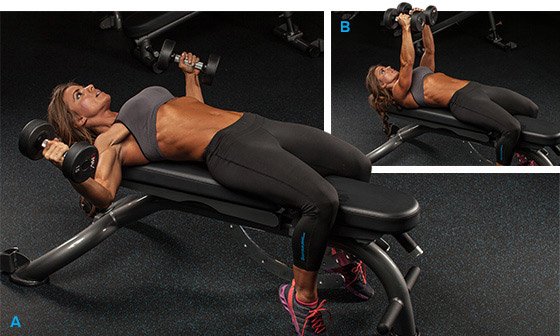
Flat-Bench Dumbbell Flyes
3 INCREASE WORKOUT VOLUME
Choosing the right exercises and doing them in the right order are the first steps to maximizing muscle growth, but there’s more. You must also do a sufficient number of exercises and sets. Fortunately, research weighs in on what’s optimal, and for individuals above the beginner level who are seeking muscle gains, it’s been shown that high-volume workouts work well for hypertrophy.
High-volume workouts help build muscle size in part by initiating the release of critical anabolic hormones responsible for muscle growth.
Training volume is a lot like the volume in your milk jug: It’s a combination of all the exercises, sets, and reps you do for a particular muscle group. If you add too much milk to the container then it spills over; too much exercise volume can be counterproductive and make a mess of your progress. The workouts below include 3-5 exercises for each major body part; larger muscle groups like legs, chest, and back are on the higher end. In addition to warm-ups, you typically include three working sets of each exercise.
4 CHOOSE THE RIGHT WEIGHT
The ideal number of reps-per-set to maximize muscle growth is 8-12. That range isn’t arbitrary—it’s been proven effective through multiple scientific studies, with the caveat being that you reach muscle failure within that rep range. But rather than simply having you perform every set for 8-12 reps, the approach used here requires that you go heavy early in your workout when your strength levels are high.
Do a few lower-rep sets early in your workout with multijoint exercises. Perform as few as six reps on some sets to prime your body for size and stimulate strength gains. As you fatigue, choose relatively higher-rep sets so that—over the course of your workout—you’ll work the target muscle with a variety of muscle-building rep targets. The rep scheme used here is arranged in what’s called pyramid fashion: You start with light weights for higher reps and progress to heavier weights for lower reps.
5 HIT EACH MUSCLE GROUP FROM MULTIPLE ANGLES
You’re probably familiar with the concept of using flat-bench, incline, and decline presses to work different areas of your chest, and that’s the same approach you should use for all body parts. In addition to the type of equipment you choose, your hand, arm, foot, and body position can all impact the focus of a particular movement. That’s why it’s important that you include different exercises within your routine to hit a muscle group from a variety of directions.
Reverse-grip pull-downs hit the lats differently than wide-grip pull-downs; likewise, curls on a preacher bench hit the biceps somewhat differently than curls seated against an incline bench. It’s important to understand how such subtle differences affect muscle recruitment and overall growth.
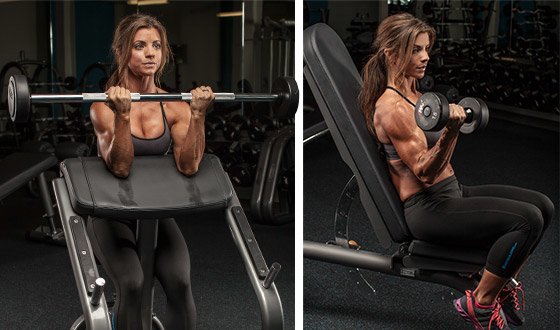
“It’s important to understand how such subtle differences affect muscle recruitment and overall growth.”
6 ADJUST REST PERIODS ON YOUR HEAVIEST SETS
While you may typically rest 1-2 minutes between sets, with slightly longer rest intervals on leg day, take a slightly longer rest period on your heaviest sets to ensure you’re fully recovered. In fact, on all sets in which you train fairly heavy—designated as sets in which you do 6-8 reps to muscle failure—rest a bit longer than normal to ensure that you’re not fatigued from the previous set. You can maintain your usual rest periods on all other sets.

“Never take light warm-up sets to muscle failure because you’ll fatigue the muscle with a weight that isn’t ideal for maximizing growth and sap strength that you need later in the workout.”
7 TRAIN TO FAILURE, BUT NOT
ON EVERY SET
Taking your sets to muscle failure—that is, the point at which you can’t do any more reps with good form on your own—is important to initiate chemical responses, both within muscle cells and via stimulating anabolic hormones. But taking every set past muscle failure is counterproductive and won’t maximize muscle gains. Instead, take just 1-2 sets of an exercise to complete muscle failure.
The best sets to take to failure are your heaviest sets. And remember, never take light warm-up sets to muscle failure because you’ll fatigue the muscle with a weight that isn’t ideal for maximizing growth and sap strength that you need later in the workout.
8 TRAIN WITH A PARTNER
When increasing the intensity of your workouts, it’s a good idea to have a spotter, not only to ensure exercise safety, but to help you work past the point of solo failure. A number of sets, especially heavy sets early in your workout, can be further intensified with advanced training techniques.
Some of the best intensity techniques that can be done with a training partner include:
Forced reps
Your spotter helps you lift a weight for an additional rep or two once you reach muscle failure.
Negative reps
You lift a weight—either alone or with help from your partner—but take up to five seconds to lower it. This slow negative—called the eccentric portion of a rep—induces damage and tension to stimulate growth.
Dropsets
On your last set of an exercise, once you hit muscle failure, have your partner quickly strip off an even amount of weight on each side of the bar. Then you immediately resume your set, taking it to a second point of muscle failure.
You want all the training and nutrition variables in place to maximize your muscle-building potential. If you’re serious about taking your training to the next level, don’t leave anything to chance!
MAXIMIZE YOUR SIZE WORKOUT
This workout doesn’t include warm-up sets; do as many as you need but never take warm-ups to muscle failure. Choose a weight on each set so you reach muscle failure by the target rep.

 Flat-Bench Dumbbell Press
Flat-Bench Dumbbell Press
2 sets of 12, 10 reps; 2 sets of 6-8 reps†•
 Incline Barbell Press
Incline Barbell Press
1 set of 12 reps; 2 sets of 8 reps†•
 Decline Machine Press
Decline Machine Press
1 set of 12 reps, 2 sets of 10 reps†
 Flat-Bench Dumbbell Fly
Flat-Bench Dumbbell Fly
3 sets of 10-12 reps
 Triceps Machine Dip
Triceps Machine Dip
2 sets of 12, 10 reps; 2 sets of 8 reps†•
 Seated Overhead Dumbbell Extension
Seated Overhead Dumbbell Extension
1 set of 12 reps; 2 sets of 8-10 reps†•
 Overhand Press-Down
Overhand Press-Down
3 sets of 10-12 reps

 Squat
Squat
2 sets of 12, 10 reps; 2 sets of 6-8 reps†•
 Leg Press
Leg Press
2 sets of 12, 10 reps; 2 sets of 8 reps†•
 Hack Squat
Hack Squat
1 set of 12 reps, 2 sets of 10 reps†
 Leg Extensions
Leg Extensions
3 sets of 10-12 reps
 Lying Leg Curls
Lying Leg Curls
2 sets of 12, 10 reps; 2 sets of 8 reps†•
 Smith-Machine Romanian Deadlift
Smith-Machine Romanian Deadlift
3 sets of 12, 8-10, 8-10 reps
 Standing Calf Raises
Standing Calf Raises
4 sets of 15, 12, 12, 12 reps
 Seated Calf Raise
Seated Calf Raise
3 sets of 15, 12, 12 reps

 Wide-Grip Lat Pull-Down
Wide-Grip Lat Pull-Down
2 sets of 12, 10 reps; 2 sets of 8 reps†•
 Bent-Over Barbell Row
Bent-Over Barbell Row
2 sets of 12, 10 reps; 2 sets of 8 reps†•
 T-Bar Row
T-Bar Row
3 sets of 12, 10, 10 reps
 Reverse-Grip Pull-Down
Reverse-Grip Pull-Down
3 sets of 10-12 reps
 Standing Barbell Curl
Standing Barbell Curl
1 set of 10 reps; 4 sets of 8 reps†•
Note: On the heavy sets, do two with a wide grip and two with a closer grip.

 Incline Dumbbell Curl
Incline Dumbbell Curl
1 set of 12 reps, 2 sets of 8-10 reps†
 EZ-Bar Preacher Curl
EZ-Bar Preacher Curl
3 sets of 12, 10, 10 reps

 Seated Overhead Dumbbell Press
Seated Overhead Dumbbell Press
2 sets of 12, 10 reps; 2 sets of 6-8 reps†•
 Standing Dumbbell Lateral Raise
Standing Dumbbell Lateral Raise
3 sets of 12, 8-10, 8-10 reps
 Barbell Front Raise (shown with dumbbells)
Barbell Front Raise (shown with dumbbells)
3 sets of 12, 8-10, 8-10 reps
 Bent-Over Lateral Raise
Bent-Over Lateral Raise
3 sets of 12, 8-10, 8-10 reps
 Barbell Shrug
Barbell Shrug
4 sets of 12, 10, 8, 8 reps
 Machine Crunch
Machine Crunch
4 sets of 15 reps
 Decline Crunch
Decline Crunch
4 sets of 20 reps
† Do 2-3 forced reps or negatives at the end of this set with assistance from a spotter, or do a drop set, reducing the weight by about 25 percent once you reach muscle failure.
• Take an extra 30-60 seconds rest before this heavy set to ensure full recovery.
Recommended For You
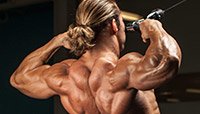
Stacked Caps: Craig Capurso’s Heavy-Volume Shoulder Workout
Suffering from ski-slope shoulders? Build a pair of mountainous deltoids with this heavy, high-volume shoulder session from Craig Capurso!
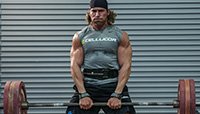
Steel Wheels: Craig Capurso’s Heavy-Volume Leg Workout
Legs lagging? Wheels out of air? Kick your lower body development into overdrive with Craig Capurso’s heavy volume workout!

Craig Capurso Back Workout: Loaded To The Max
Big backs are wonders of the fit world, but they aren’t built in one workout. Load your latissimus for the long haul, and start building with this heavy duty workout.
The 8 Critical Keys For Building Big Muscle




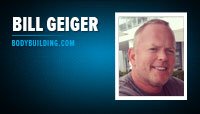
No comments:
Post a Comment